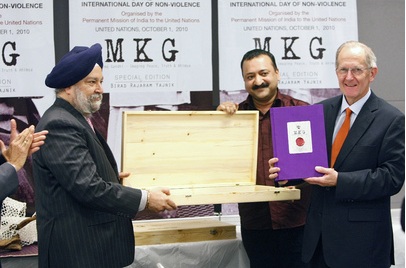I must admit that by the end the “Peace, Truth, and Ahimsa” session that I experienced today, I was overwhelmed with a sense of joy. ‘Joy’, not out of the information and moral values I garnered during my visit, but ‘joy’ because something ‘different’ was being done about ‘Mahatma Gandhi’. The idea of taking Gandhi as an ideology rather than a person of historic significance, was the underlying difference between Bapu Ghat “Gandhi Digital Museum” and the other Gandhi memorabilia I have witnessed. By the end of today’s session there were only three lessons to take back from this outstanding museum- ‘believe that you can and then you can’, ‘whatever the circumstances are, one must stand by their conscience’, and lastly, ‘think like Gandhi; think differently’.
The entire digital museum experience is
coordinated exceptionally well. Every part of the experience was illustrated
according to the level of the understanding of the audience. I witnessed the
program along with a group of teenage students. Handling these reckless
teenagers no doubt was an arduous task, yet the museum anchors successfully
managed to titillate their curiosity time and again, throughout the entire
session.
The introduction was close to perfect. The
crux of this session was to place Gandhi in the context of the 21st
century and show the relevance his message has for all of us. Here I feel that
it would be nice if the anchor calls a few members of the audience and asks them
to narrate their personal interaction with Gandhi. This will enable the anchors
to understand their audience better.
The yoga, meditation session should in my
opinion be shortened to include Gandhi’s notions of “Karma yoga”; what he
practiced in his life. For example it should include activities like sweeping
the Bapu Ghat auditorium or washing plates after the sumptuous lunch (also a
way of eliminating plastic from the meals). Gandhi Ji’s stress on physical work
is something that should be considered to create an understanding of the Man
himself. The meditation in this session can include the Tibetan Buddhist
meditation on ‘equanimity’ for audiences of higher age groups.
The digital interaction is a masterpiece
selection for school children. It is the perfect way to introduce Gandhi and
learn about who he is. The selection of movies too is magnum opus. This
selection aptly portrays what Gandhi wanted to tell all of us. The selected
videos also stick in the mind and really manage to create an impact.
The finale though unexpected and different
was not to my taste. Maybe this is because I have never found any fascination
for motorcycles and such material things. But I think it works perfectly for
the ‘ordinary’ human; it gives him the 21st century “cool” symbol
for peace. At the finale maybe the anchors can conduct a short discussion and a
short reading session of Gandhi’s writings.
On the whole I thoroughly enjoyed my three
four hour experience at the museum. I mentioned earlier, adding a few
activities and including a session of active discussion would enhance the
existing program.
- Soham








